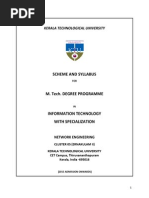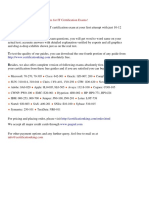0 ratings0% found this document useful (0 votes)
555 viewsProgramming Paradigm Ktu Syllabus
This document describes a course on programming paradigms that introduces basic programming language concepts. The course objectives are to introduce fundamental programming constructs, programming language design principles, and how to learn new languages. The syllabus covers topics like variable scoping, control flow, data types, subroutines, functional and object-oriented programming, and concurrency. Students will learn to analyze and compare features of different languages. The course includes lectures, assignments, and exams.
Uploaded by
Aashi ashiCopyright
© © All Rights Reserved
Available Formats
Download as PDF, TXT or read online on Scribd
0 ratings0% found this document useful (0 votes)
555 viewsProgramming Paradigm Ktu Syllabus
This document describes a course on programming paradigms that introduces basic programming language concepts. The course objectives are to introduce fundamental programming constructs, programming language design principles, and how to learn new languages. The syllabus covers topics like variable scoping, control flow, data types, subroutines, functional and object-oriented programming, and concurrency. Students will learn to analyze and compare features of different languages. The course includes lectures, assignments, and exams.
Uploaded by
Aashi ashiCopyright
© © All Rights Reserved
Available Formats
Download as PDF, TXT or read online on Scribd
You are on page 1/ 3
Course Year of
Course Name L-T-P Credits
code Introduction
CS403 PROGRAMMING PARADIGMS 3-0-0-3 2016
Course Objectives:
To introduce the basic constructs that underlie all programming languages
To introduce the basics of programming language design and implementation
To introduce the organizational framework for learning new programming languages.
Syllabus:
Names, Scopes, and Bindings - Binding Time, Scope Rules, Storage Management, Overloading,
Polymorphism; Control Flow - Expression Evaluation, Structured and Unstructured Flow, Non-
determinacy; Data Types - Type Systems, Type Checking, Equality Testing and Assignment;
Subroutines and Control Abstraction - Static and Dynamic Links, Calling Sequences, Parameter
Passing, Exception Handling, Co-routines; Functional and Logic Languages; Data Abstraction
and Object Orientation -Encapsulation, Inheritance, Dynamic Method Binding; Innovative
features of Scripting Languages; Concurrency - Threads, Synchronization, Language-Level
Mechanisms; Run-time program Management.
Expected Outcome:
The Students will be able to :
i. compare scope and binding of names in different programming languages
ii. analyze control flow structures in different programming languages
iii. appraise data types in different programming languages
iv. analyze different control abstraction mechanisms
v. appraise constructs in functional, logic and scripting languages
vi. analyze object oriented constructs in different programming languages
vii. compare different concurrency constructs
viii. interpret the concepts of run- time program management
Text book:
1. Scott M L, Programming Language Pragmatics, 3rd Edn., Morgan Kaufmann Publishers,
2009.
References:
1. David A Watt, Programming Language Design Concepts, Wiley Dreamtech, 2004
2. Ghezzi C and M. Jazayeri, Programming Language Concepts, 3rd Edn, Wiley.1997
3. Kenneth C Louden, Programming Languages: Principles and Practice, 3rd Edn., Cengage
Learning, 2011.
4. Pratt T W, M V Zelkowitz, and T. V. Gopal, Programming Languages: Design and
Implementation, 4th Edn., Pearson Education, 2001
5. R W Sebesta, Concepts of Programming Languages, 11th Edn., Pearson Education, 2015
6. Ravi Sethi, Programming Languages: Concepts & Constructs, 2nd Edn., Pearson
Education, 2006
7. Tucker A B and R E Noonan, Programming Languages: Principles and Paradigms, 2nd
Edn,McGraw Hill, 2006.
Course Plan
End
Sem.
Module Contents Hours
Exam
Marks
Names, Scopes and Bindings:- Names and Scopes, Binding Time,
Scope Rules, Storage Management, Binding of Referencing
Environments. 7 15 %
I Control Flow: - Expression Evaluation, Structured and
Unstructured Flow, Sequencing, Selection, Iteration, Recursion,
Non-determinacy.
Data Types:-Type Systems, Type Checking, Records and Variants,
II Arrays, Strings, Sets, Pointers and Recursive Types, Lists, Files 15 %
and Input/Output, Equality Testing and Assignment. 7
FIRST INTERNAL EXAM
Subroutines and Control Abstraction: - Static and Dynamic Links,
III Calling Sequences, Parameter Passing, Generic Subroutines and 7 15 %
Modules, Exception Handling, Co-routines.
Functional and Logic Languages:- Lambda Calculus, Overview of
Scheme, Strictness and Lazy Evaluation, Streams and Monads, 7 15 %
IV
Higher-Order Functions, Logic Programming in Prolog,
Limitations of Logic Programming.
SECOND INTERNAL EXAM
Data Abstraction and Object Orientation:-Encapsulation,
Inheritance, Constructors and Destructors, Aliasing, Overloading,
V 7 20 %
Polymorphism, Dynamic Method Binding, Multiple Inheritance.
Innovative features of Scripting Languages:-Scoping rules, String
and Pattern Manipulation, Data Types, Object Orientation.
Concurrency:- Threads, Synchronization.
Run-time program Management:- Virtual Machines, Late Binding 7 20 %
VI
of Machine Code, Reflection, Symbolic Debugging, Performance
Analysis.
END SEMESTER EXAM
Question Paper Pattern (End semester exam)
1. There will be FOUR parts in the question paper – A, B, C, D
2. Part A
a. Total marks : 40
b. TEN questions, each have 4 marks, covering all the SIX modules (THREE
questions from modules I & II; THREE questions from modules III & IV;
FOUR questions from modules V & VI).
All the TEN questions have to be answered.
3. Part B
a. Total marks : 18
b. THREE questions, each having 9 marks. One question is from module I;
one question is from module II; one question uniformly covers modules I &
II.
c. Any TWO questions have to be answered.
d. Each question can have maximum THREE subparts.
4. Part C
a. Total marks : 18
b. THREE questions, each having 9 marks. One question is from module III;
one question is from module IV; one question uniformly covers modules III
& IV.
c. Any TWO questions have to be answered.
d. Each question can have maximum THREE subparts.
5. Part D
a. Total marks : 24
b. THREE questions, each having 12 marks. One question is from module V;
one question is from module VI; one question uniformly covers modules V
& VI.
c. Any TWO questions have to be answered.
d. Each question can have maximum THREE subparts.
6. There will be AT LEAST 50% analytical/numerical questions in all possible
combinations of question choices.
You might also like
- Building Microservice Architectures Neal Ford PDFNo ratings yetBuilding Microservice Architectures Neal Ford PDF80 pages
- B.Tech CSE (S7 S8) SYL CP 18 02 2018 - DRAFT PDFNo ratings yetB.Tech CSE (S7 S8) SYL CP 18 02 2018 - DRAFT PDF55 pages
- CSPC31-Principles of Programming LanguageNo ratings yetCSPC31-Principles of Programming Language6 pages
- Cse223 Principles-Of-programming TH 1.00 Ac26No ratings yetCse223 Principles-Of-programming TH 1.00 Ac262 pages
- Principles of Programming Languages - CS F30 - 2024_handoutNo ratings yetPrinciples of Programming Languages - CS F30 - 2024_handout6 pages
- CSI2120 Course_Syllabus_MAlnabhan_Winter2025No ratings yetCSI2120 Course_Syllabus_MAlnabhan_Winter20257 pages
- CS F301 Principles of Programming Languages I Sem 2021-22 HONo ratings yetCS F301 Principles of Programming Languages I Sem 2021-22 HO4 pages
- II Year Course Structure and Syllabus ModifiedNo ratings yetII Year Course Structure and Syllabus Modified60 pages
- FIRST SEMESTER 2020-2021: 1. of Programming Languages 10 Edition 1No ratings yetFIRST SEMESTER 2020-2021: 1. of Programming Languages 10 Edition 13 pages
- FIRST SEMESTER 2022-2023: of Programming Languages 10 Edition, Pearson, 2012.No ratings yetFIRST SEMESTER 2022-2023: of Programming Languages 10 Edition, Pearson, 2012.3 pages
- CS482 Data Structures (Ktustudents - In)No ratings yetCS482 Data Structures (Ktustudents - In)3 pages
- Subject Description Form: Subject Code Subject Title Credit Value Pre-Requisite / Co-Requisite/ ExclusionNo ratings yetSubject Description Form: Subject Code Subject Title Credit Value Pre-Requisite / Co-Requisite/ Exclusion4 pages
- CS 114 Fundamentals of Programming - Fall 2019 - Zunera - FinalNo ratings yetCS 114 Fundamentals of Programming - Fall 2019 - Zunera - Final4 pages
- Principles of Programming Languages - Nov - 2015No ratings yetPrinciples of Programming Languages - Nov - 20155 pages
- Course Log - Theory of Programming LanguagesNo ratings yetCourse Log - Theory of Programming Languages6 pages
- WWW - Manaresults.Co - In: II B. Tech II Semester Model Examinations, March 2018 Principles of Programming LanguagesNo ratings yetWWW - Manaresults.Co - In: II B. Tech II Semester Model Examinations, March 2018 Principles of Programming Languages4 pages
- Cs f301 Principles of Programming LanguagesNo ratings yetCs f301 Principles of Programming Languages5 pages
- Teaching Beginners Prolog How To Teach PrologNo ratings yetTeaching Beginners Prolog How To Teach Prolog23 pages
- Gitam: Department of Computer Science & Engineering and Department of Information TechnologyNo ratings yetGitam: Department of Computer Science & Engineering and Department of Information Technology5 pages
- AP Computer Science A Premium, 12th Edition: Prep Book with 6 Practice Tests + Comprehensive Review + Online PracticeFrom EverandAP Computer Science A Premium, 12th Edition: Prep Book with 6 Practice Tests + Comprehensive Review + Online PracticeNo ratings yet
- C# Algorithms for New Programmers: A Practical Guide with ExamplesFrom EverandC# Algorithms for New Programmers: A Practical Guide with ExamplesNo ratings yet
- Academic English for Computer Science: Academic EnglishFrom EverandAcademic English for Computer Science: Academic EnglishNo ratings yet
- Mastering Generic Programming in C++: Unlock the Secrets of Expert-Level SkillsFrom EverandMastering Generic Programming in C++: Unlock the Secrets of Expert-Level SkillsNo ratings yet
- C# Debugging from Scratch: A Practical Guide with ExamplesFrom EverandC# Debugging from Scratch: A Practical Guide with ExamplesNo ratings yet
- Scalable Javascript Application Architecture: Nicholas C. Zakas - @slicknetNo ratings yetScalable Javascript Application Architecture: Nicholas C. Zakas - @slicknet108 pages
- Node JS - Design Pattern: Jose J TharayilNo ratings yetNode JS - Design Pattern: Jose J Tharayil14 pages
- Security Challenges Posed by Mobile DevicesNo ratings yetSecurity Challenges Posed by Mobile Devices9 pages
- Car Renting Management System Proposal PDFNo ratings yetCar Renting Management System Proposal PDF3 pages
- Conditional Control Structure Chap - 04 - Class - 10No ratings yetConditional Control Structure Chap - 04 - Class - 1018 pages
- CS 112: Data Structures Fall 2020 Big O Analysis: Quick ReviewNo ratings yetCS 112: Data Structures Fall 2020 Big O Analysis: Quick Review12 pages
- Implementation of Round Robin Scheduling by MOHAMMAD GHUFRAN - 19DCS030No ratings yetImplementation of Round Robin Scheduling by MOHAMMAD GHUFRAN - 19DCS0305 pages

























































































